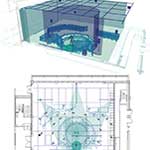cove
island of lost baggage
Cove extended Bonemap’s appreciation of atmospheric conditions towards a prototype immersive installation influenced and inspired by the patterns, movements and serialisation in the natural world, was the reflection of an imaginary geography. The awareness of place within the imaginary of the artist allowed the work to wander into surrealistic representation. Contemporary notions of magical realism1 and assimilation of Indigenous knowledge was linked to the phenomenology of ‘wonders’ and ‘marvels’. The marvelous reality of the tropical environment included such biological features as bioluminescence and iridescence. The qualities of biological light emission2 and spectacular diffraction of light as structural iridescence3 were scintillating patterns of light that influenced the media art and design proposed for Cove. The configuration of an interactive gossamer light curtain formed a diaphanous separation of a dancer and the audience and it was through the light curtain that the synthesis of an imaginary world and representation of marvelous atmospheric ‘weather’ phenomena was produced. The scintillation was a layer of atmospheric light and sound spatialisation responsive to movement in a pre-defined zone.
The Cove is an allusion to a small sheltered landform. Assembled by a scenography of hundreds of suitcases in piles, the shape and form resembled that of a bay. The luggage handler was no longer an operative in the territory and those seeking its asylum appeared to have abandoned their carriage on these shores and vanished. Was it exclusion or expulsion? The lost baggage island of Bonemap’s Cove was also the immigrant’s loss of a material life in the “liminal zones where the conditions of existence are reduced to ... ‘bare life’”4. The audience was a transient visitor to the Cove and witness to a single arrival, as the dancer appeared through the diaphanous screen, trailed by a large marine trunk.
Bonemap’s artwork Cove was a metaphor of human psycho-geography that seeks to imagine place as a layered cultural landscape. Cove represented the once-colonized world shaped by “a modernity that is scored by the claws of colonialism, left full of contradictions, of half-finished processes, of confusions, of hybridity, and liminalities”5 .
Cove can be described as an interactive media arts experience that transformed the interior of the theatre into an immersive space that placed the audience at the centre of an imaginary geography. It wasa subtle interactive space filled with ephemeral light sources, projection and sound. The meteorological and atmospheric effects created a transformative environment inhabited by the performer and audient. Large forms integrated into the work as both sculptural elements and projection surfaces like ancient landmasses. The fleeting atmospheric effects in the work represented the sanctuary of a ‘cove’. Sculptural representations of sea passages and landing sites integrated with media and performance to complete the immersive quality of the installation.
Full text available (download PDF 65k)
Reference List
Gilbert, H & Lo, J 2009, Performance and Cosmopolitics: cross-cultural transactions in Australasia, Studies in International Performance, Plagrave Macmillan, Hampshire, England.
Reeds, K 2006, 'Magical Realism: a Problem of Definition', Neophilologus, vol. 90, no. 2, pp. 175-96.
Rodgerson, DJ 2011, Bioluminescence: characteristics, adaptations, and biotechnology, Nova Science Publishers, New York.
Stavenga, DG, Leertouwer, HL, Marshall, NJ & Osorio, D 2011, 'Dramatic colour changes in a bird of paradise caused by uniquely structured breast feather barbules', Proceedings.Biological sciences / The Royal Society, vol. 278, no. 1715, pp. 2098-104.
Yeoh, B 2009, 'post-colonialism', in The Dictionary of Human Geography, Blackwell Publishers.
1 For a discussion of magical realism see Reeds 2006, ‘Magical Realism: a Problem of Definition’.
2 For an account of bioluminescence see Rodgerson’s 2011 ‘Bioluminescence: characteristics, adaptations, and biotechnology’.
3 Stavenga et. al. provided notes on the material structure that forms iridescence.
4 (Gilbert & Lo 2009: 186)
5 (Lee & Lam in Yeoh 2009)
Russell Milledge and Rebecca Youdell of Bonemap have collaborated with sound artist Steven Campbell, computer programmer Jason Holdsworth and other creative artists to construct an innovative new work dealing with the nature of space, the cultural significance and ephemeral quality of light and performance – dancing light.
sponsors:
Centre of Contemporary Arts Cairns, KickArts Contemporary Arts, James Cook University, Cairns Regional Council, Arts Queensland
Reviews:
Bernadette Ashley | RealTime #97


















